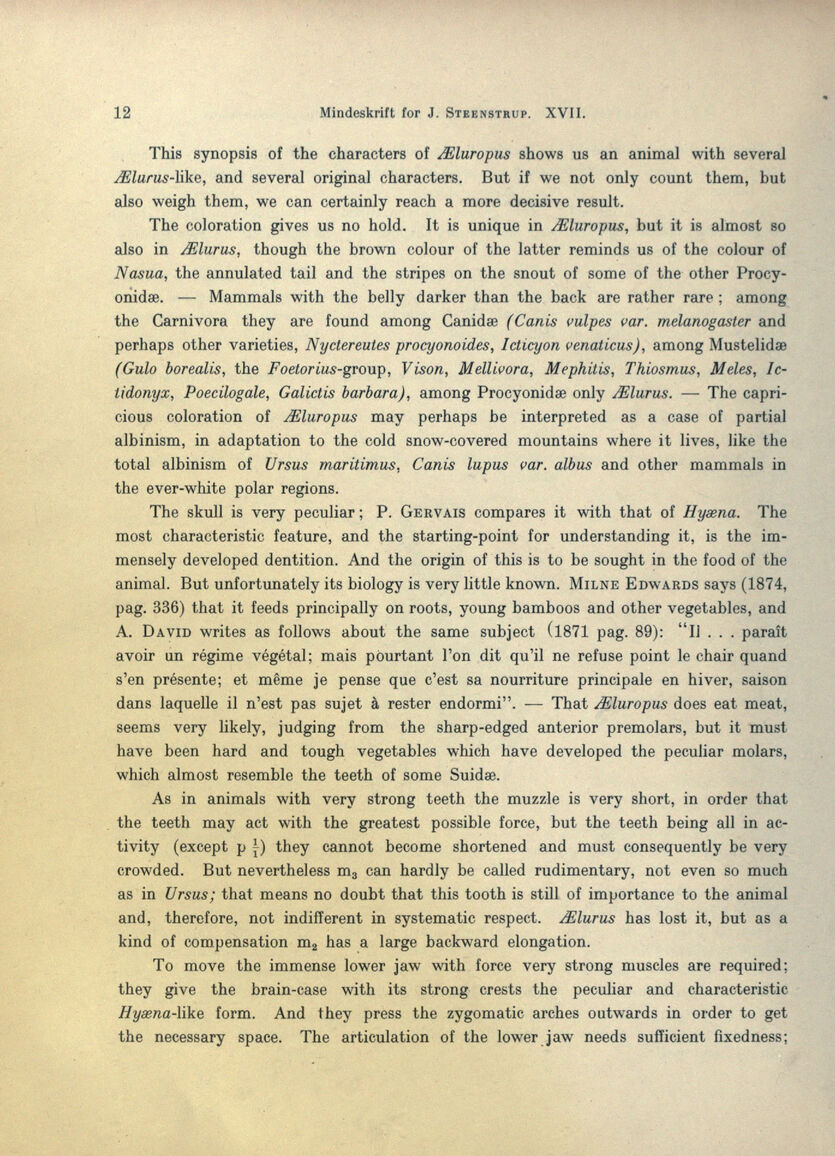
Full resolution (JPEG) - On this page / på denna sida - On the Systematic Position of Æluropus Melanoleucus

<< prev. page << föreg. sida << >> nästa sida >> next page >>
Below is the raw OCR text
from the above scanned image.
Do you see an error? Proofread the page now!
Här nedan syns maskintolkade texten från faksimilbilden ovan.
Ser du något fel? Korrekturläs sidan nu!
This page has been proofread at least once.
(diff)
(history)
Denna sida har korrekturlästs minst en gång.
(skillnad)
(historik)
This synopsis of the characters of Æluropus shows us an animal with several
Ælarus-like, and several original characters. But if we not only count them, but
also weigh them, we can certainly reach a more decisive result.
The coloration gives us no hold. It is unique in Æluropus, but it is almost so
also in Ælurus, though the brown colour of the latter reminds us of the colour of
Nasua, the annulated tail and the stripes on the snout of some of the other
Procyonidæ. — Mammals with the belly darker than the back are rather rare; among
the Carnivora they are found among Canidæ (Canis vulpes var. melanogaster and
perhaps other varieties, Nyctereutes procyonoides, Icticyon venaticus), among Mustelidæ
(Gulo borealis, the Foetorius-group, Vison, Mellivora, Mephitis, Thiosmus, Meles,
Ictidonyx, Poecilogale, Galictis barbara), among Procyonidæ only Ælurus. — The
capricious coloration of Æluropus may perhaps be interpreted as a case of partial
albinism, in adaptation to the cold snow-covered mountains where it lives, like the
total albinism of Ursus maritimus, Canis lupus var. alhus and other mammals in
the ever-white polar regions.
The skull is very peculiar; P. Gervais compares it with that of Hyæna. The
most characteristic feature, and the starting-point for understanding it, is the
immensely developed dentition. And the origin of this is to be sought in the food of the
animal. But unfortunately its biology is very little known. Milne Edwards says (1874,
pag. 336) that it feeds principally on roots, young bamboos and other vegetables, and
A. David writes as follows about the same subject (l871 pag. 89): “Il . . . paraît
avoir un régime végétal; mais pourtant l’on dit qu’il ne refuse point le chair quand
s’en présente; et même je pense que c’est sa nourriture principale en hiver, saison
dans laquelle il n’est pas sujet à rester endormi”. — That Æluropus does eat meat,
seems very likely, judging from the sharp-edged anterior premolars, but it must
have been hard and tough vegetables which have developed the peculiar molars,
which almost resemble the teeth of some Suidæ.
As in animals with very strong teeth the muzzle is very short, in order that
the teeth may act with the greatest possible force, but the teeth being all in
activity (except p 1/1) they cannot become shortened and must consequently be very
crowded. But nevertheless m3 can hardly be called rudimentary, not even so much
as in Ursus; that means no doubt that this tooth is still of importance to the animal
and, therefore, not indifferent in systematic respect. Ælurus has lost it, but as a
kind of compensation m2 has a large backward elongation.
To move the immense lower jaw with force very strong muscles are required;
they give the brain-case with its strong crests the peculiar and characteristic
Hyæna-like form. And they press the zygomatic arches outwards in order to get
the necessary space. The articulation of the lower jaw needs sufficient fixedness;
<< prev. page << föreg. sida << >> nästa sida >> next page >>